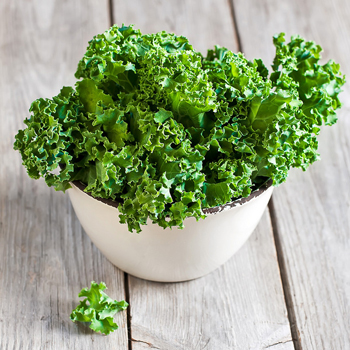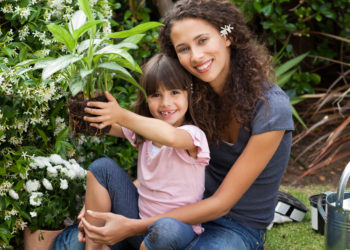Kale is a superfood, and incidentally, is one of the 12 foods most nutritionists eat regularly. Rich in vitamins A, C and K, kale also provides 9 percent of the recommended daily intake of calcium and it’s loaded with minerals and phytonutrients.
You don’t have to take our word for it. We did some research and will make it easy for you to verify our information. You can find the complete nutritional information for kale eaten raw or for boiled kale by following these links. You will also find the estimated glycemic load, its inflammation factor, its nutrient balance score and how its proteins rate in terms of quality.
Sokale is exceptionally nutritious and ridiculously low in calories, but the question we hear most often is, How do you prepare it?
 We’ll start with our recommendation to grow it yourself if you can. It’s relatively easy to grow and easy to harvest. Growing your own kale will save you $$ and provide you with a ready resource for this super food, though the biggest advantage we see is that when you grow it yourself you know exactly what has been used to fertilize it and to control pests. You also know how it’s been harvested and handled. In short, you will not have to fear listeria, e-coli or any of those other bad bugs you worry about when you buy grocery store produce. You can harvest it at its freshest, knowing you are getting the ultimate nutritional kick from your kalelike any other produce you grow at home. We challenge you to grow your own!
We’ll start with our recommendation to grow it yourself if you can. It’s relatively easy to grow and easy to harvest. Growing your own kale will save you $$ and provide you with a ready resource for this super food, though the biggest advantage we see is that when you grow it yourself you know exactly what has been used to fertilize it and to control pests. You also know how it’s been harvested and handled. In short, you will not have to fear listeria, e-coli or any of those other bad bugs you worry about when you buy grocery store produce. You can harvest it at its freshest, knowing you are getting the ultimate nutritional kick from your kalelike any other produce you grow at home. We challenge you to grow your own!
Growing Kale
You may have heard that kale prefers cold weather, but the truth is that you can grow it during any season and in almost any climate. Kale is an exceptionally hardy crop that can withstand temperatures as low as 20°F and can be grown in hot weather as well, though we recommend harvesting it young when temperatures rise above 80°F. More mature kale growing in hot temperatures may become a little bitter and a bit tough (though massaging the leaves well with your favorite oil will result in a tender, tasty dish). Some gardeners grow kale well into the winter by heavily mulching around the plants just before or after the first hard freeze.
You can grow kale in pots, moving the containers to a partially shaded area when the temperatures rise; or you can grow it in your garden and provide shade with a shade cloth if you want a non-stop, tender, scrumptious and flavorful supply. We recommend full sun if garden growing during a cooler season and a partially shaded spot if growing kale in the garden during the hottest days of the summer.
Kale isn’t super picky, but it will grow best with a soil pH between 5.5 and 6.5. It does not like a nitrogen-rich growing medium, preferring a loamy, well-drained, somewhat moist (not consistently wet) soil. However, sandy and clay soils will also yield good crops with proper watering. Kale seeds will germinate in soil temperatures as low as 40°F, though the ideal soil temperature for germination is about 70°F. You can also buy kale plants already growing and guaranteed to arrive alive and ready to thrive.
 If planting a fall crop, your best bet is to rely upon NOAA’s (National Oceanic and Atmospheric Administration) Freeze/Frost data. Just click the link and select your state. Once the PDF for your state comes up, locate your city (or the one closest to you), and find the date under the Fall (Date)/50 column. That is the ideal date for harvest in your area. Count backwards from that date the number of days from planting to harvest (i.e., if your variety of kale takes 55 days to mature, count back 55 days), and that is the approximate date you should plant. You can, of course, plant earlier and you can also plant up to 10 days later. This is true of any fall crop, including kale.
If planting a fall crop, your best bet is to rely upon NOAA’s (National Oceanic and Atmospheric Administration) Freeze/Frost data. Just click the link and select your state. Once the PDF for your state comes up, locate your city (or the one closest to you), and find the date under the Fall (Date)/50 column. That is the ideal date for harvest in your area. Count backwards from that date the number of days from planting to harvest (i.e., if your variety of kale takes 55 days to mature, count back 55 days), and that is the approximate date you should plant. You can, of course, plant earlier and you can also plant up to 10 days later. This is true of any fall crop, including kale.
Harvesting Kale
First, avoid harvesting the terminal bud found at the top center of the plant. Harvesting around this bud will keep your kale plants productive for a much longer period of time. The smaller, more tender leaves are ideal for eating raw in just about any type of salad you can imagine or right out of the garden, while the more mature leaves are usually used for adding to soups or stews, for sautéing, or prepared in the same manner as you would any type of cooked greens, like spinach or collards. If you harvest more mature leaves that seem a bit tough and/or bitter, remember that massaging them with a tiny bit of olive oil will restore the tenderness and dilute the bitterness.
Storing Kale
If you plan to use your kale within 5 to 7 days, you can simply refrigerate it in a plastic bag. Don’t wash it until it’s ready to use; or if you wash it, make sure it is completely dry before putting it in the bag and into the fridge.
If you’d like to stock up on fresh kale, it can be frozen for up to 12 months without sacrificing quality or nutritional value. Wash it thoroughly, cutting off the larger, woody stems, but keeping it in serving-size bunches. Then blanch it in boiling water for 2 minutes, immediately plunging it into ice water after the boiling water bath. Drain or spin off the excess moisture and package in airtight plastic containers or freezer bags, with as little trapped air as possible. If you have a deep freeze (consistently at 0°), you can store just about anything indefinitely.
Finally to answer the question, How Do You Prepare Kale?
There are, of course, numerous resources for tried and tested kale recipes. Here are the Top 20 Kale Recipes from one of our favorites. However, once you have the basics of kale preparation down-pat, you can experiment, adjust and create your own recipes to fit your lifestyle, your tastes and your garden. And then share them with us!
We challenge you to be creative and to dream up new, innovative and delicious ways to serve this super veggie.
We wish you happy and healthy gardening from all of us at GrowJoy.





No Comments